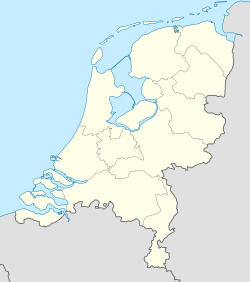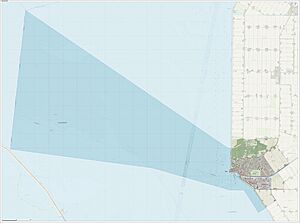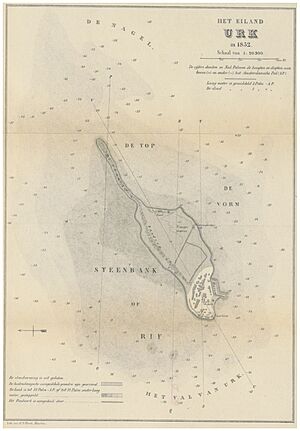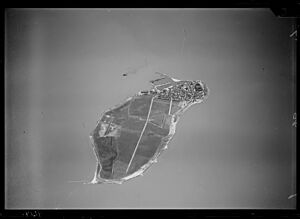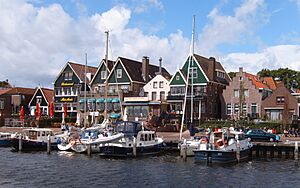Urk facts for kids
Quick facts for kids
Urk
Urrek
|
|||
|---|---|---|---|
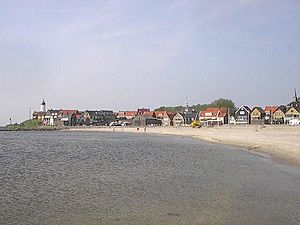
Current town and former island of Urk
|
|||
|
|||
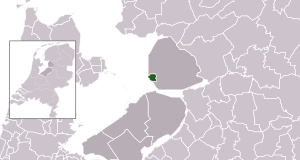
Location in Flevoland
|
|||
| Country | Netherlands | ||
| Province | Flevoland | ||
| Government | |||
| • Body | Municipal council | ||
| Area | |||
| • Total | 109.91 km2 (42.44 sq mi) | ||
| • Land | 11.53 km2 (4.45 sq mi) | ||
| • Water | 98.38 km2 (37.98 sq mi) | ||
| Elevation | 0 m (0 ft) | ||
| Population
(May 2014)
|
|||
| • Total | 19,567 | ||
| • Density | 1,697/km2 (4,400/sq mi) | ||
| Demonym(s) | Urker | ||
| Time zone | UTC+1 (CET) | ||
| • Summer (DST) | UTC+2 (CEST) | ||
| Postcode |
8320–8324
|
||
| Area code | 0527 | ||
Urk is a small town and municipality in the Flevoland province of the Netherlands. For a long time, Urk was an island. It was surrounded by a large inland sea called the Almere, which later became the Zuiderzee.
In 1939, a special dike was built to connect Urk to the mainland. This meant Urk was no longer an island! Around the same time, the salty Zuiderzee was turned into a freshwater lake called the IJsselmeer. Later, the land around Urk was reclaimed from the sea, creating the Noordoostpolder.
Fishing has always been super important to Urk's economy. Even today, fishing boats from Urk bring in seafood that is sold all over the world. People in Urk are also very religious, and their churches play a big part in community life.
Contents
Geography of Urk
Urk is located near the IJsselmeer lake. This area was shaped by ice ages long ago. Urk itself is the highest point in the province of Flevoland.
Hundreds of years ago, the sea level rose, and big storms changed the land. A huge storm in 1287 created the Zuiderzee, turning the water around Urk into a tidal sea. This meant the water level went up and down with the ocean tides.
Because there were no strong sea defenses, parts of the island slowly washed away. The southwest side of Urk, which stood tall out of the sea, was known as "the High Cliff." Around the year 1700, the city of Amsterdam helped Urk by building sea defenses to protect it.
Urk's Past

The name "Urk" first appeared in a document from the year 966. This document described it as an island in the middle of the Almere lake. For many centuries, different families and cities ruled Urk. From 1660 to 1792, Urk was part of the city of Amsterdam.
After World War II, Urk stopped being an island. The land around it was reclaimed from the sea, creating the polder. This new land allowed Urk to grow. Many people who had left Urk because it was too crowded could now return.
Urk has also been part of different provinces over time. From 1792 to 1950, it was in North Holland. Then from 1950 to 1986, it was in Overijssel. Since 1986, Urk has been part of the province of Flevoland. The area around Urk was even sometimes called "Urker Land."
Urk's Economy
Fishing is still the most important part of Urk's economy. After the IJsselmeer was formed, the fishermen of Urk started going to the North Sea to catch fish.
Urk is also working to grow other parts of its economy. These include tourism, shops, and services related to the sea. The local government wants to encourage more visitors and support the fishing industry.
In the past, many fishermen lost their lives in storms on the Zuiderzee and North Sea. There is a special memorial in Urk for these lost fishermen. It's a statue of a woman looking out to sea, waiting for her husband and sons to return. People call it the Urker vrouw (Urk woman).
Urkish Dialect
The language spoken in Urk is a very old and unique dialect of Dutch. Almost everyone in the village speaks it every day. This dialect is quite different from regular Dutch. It has kept many old words and sounds that have disappeared from standard Dutch.
For example, the old word for "father" in the Urkish dialect is taote. The dialect developed this way because Urk was an island until World War II. People could only reach it by boat. Most people were poor and didn't have radios, newspapers, or books. Children often only went to school for two years before they had to help their families.
The Urkish dialect has more vowel sounds than standard Dutch. The way vowels are pronounced is also closer to English.
In the past, many young girls from Urk, around 11 or 12 years old, would leave the island to work as house helpers, often in Amsterdam. They sometimes worked for Jewish families. After a few years, they would return to Urk to start their own families. Because of this, the Urkish dialect picked up some words from the Amsterdam dialect and even from Yiddish. For example, the Yiddish word "Shnur" for "sister-in-law" became "Snoar" in Urkish.
When Napoleon took over the Netherlands, many French words became part of both standard Dutch and the Urkish dialect. The Urkish dialect has mostly been a spoken language. Only recently have people started writing stories and poems in it. Some people have even translated parts of the Bible into Urkish. Even though Urk is no longer an island and people hear standard Dutch everywhere, the special Urkish dialect is still very much alive.
Famous People from Urk
- A. C. Baantjer (1923–2010) was a Dutch writer famous for his detective novels.
- Geert Nentjes (born 1998) is a professional darts player who lives in Urk.
- Jan Ras (born 1999) is a Dutch football player.
- Dick Schutte (born 1947) was the mayor of Urk from 1999 to 2005.
Fun Folktales
The Ommelebommelestien
There's a famous folktale in Urk about where babies come from! It involves a large rock in the IJsselmeer lake, about 30 meters (98 feet) from the shore. This rock is called the "Ommelebommelestien."
People in Urk often tell their children that there are two kinds of people: vreemden (strangers) and Urkers (people from Urk). Strangers might be born from a cabbage or brought by a stork. But Urkers, they say, come from this special stone!
In the story, a stork flies all the way from Egypt to put babies in the stone. When a baby is about to be born, the father has to go to Schokland to get the key that opens the stone. So, if someone asks an Urkish man if he's been to Schokland, they're really asking if he has children!
In the old days, when both Urk and Schokland were islands, the father had to row a boat to Schokland for the key. Then he'd row to the Ommelebommelestien to get the baby. Even today, the legend says he still has to row, even though you can drive to Schokland now. The door to the stone is underwater, so it's hard to find. Once found, there was a small fee for the baby: one Dutch guilder for a girl and two for a boy. The mother would stay in bed with a nail through her right foot to celebrate becoming a mom!
Urk and the Arts
The famous Dutch writer A. C. Baantjer was born in Urk. He is best known for his many detective novels about Inspector De Cock.
Another Dutch writer, Jef Last, lived in Urk for several years starting in 1932. He wrote articles about Urk and was inspired to write a novel called Zuiderzee.
The Dutch writer, painter, and resistance hero Willem Arondeus also spent time in Urk around 1920. While there, he wrote a collection of poems.
Population and Families
Religions in Urk (2013) Protestantism (82.2%) Roman Catholic (1.7%) Other Christian denomination (13.8%) Irreligion (2.3%)
Urk has one of the highest birth rates in the Netherlands. This means many babies are born there each year compared to other places. However, like many other towns, the birth rate in Urk has slowly gone down over the years.
Getting Around Urk
Urk does not have its own railway station. The closest train stations are about 30 kilometers (19 miles) away in Kampen, Dronten, and Lelystad. This makes Urk one of the more isolated places in the Netherlands when it comes to train travel.
Images for kids
See also
 In Spanish: Urk para niños
In Spanish: Urk para niños





